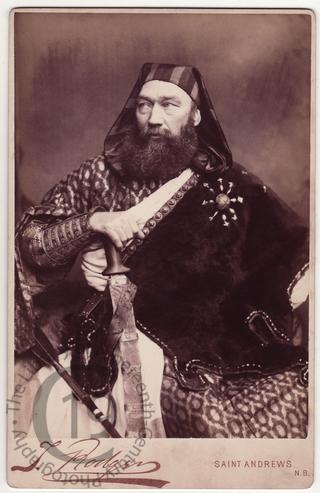
Captain Tristram Speedy
A cabinet card portrait of the English explorer and adventurer Tristram Charles Sawyer Speedy (1836-1911), usually known as ‘Captain Speedy’.
Born the son of an army officer in India, he was educated in England but subsequently returned to India as an army officer himself. He served in the North-West Province from 1854 to 1860 and saw action in the Punjab and during the Indian Mutiny. While hunting in the Horn of Africa, Speedy was summoned to the court of Emperor Tewodros II of Ethiopia, who bestowed on him the title Basha Felika ('Sir Speedy' or 'Commander Speedy'). Originally employed by Tewodros to train his army, the two men soon fell out and Speedy had to flee the country. He next served as British vice-consul at the Red Sea port of Massawa but in early 1864 Speedy resigned to travel to New Zealand, where he served in the Waikato Militia. He was promoted to captain in 1864, and received the Maori Wars medal.
During the 1868 Expedition to Abyssinia Speedy's knowledge of Ethiopia was crucial to the commander, Sir Robert Napier. He was recalled to join the expedition and received the Abyssinian War Medal. After an audience with Queen Victoria, Speedy was appointed guardian to the young prince Alamayu, son of the late Emperor Tewodros, who had committed suicide rather than be captured by the British.
Speedy married Cornelia Cotton in England, then returned to India with his wife and the Abyssinian prince. [The British government subsequently decided Alamayu should be educated in England, where he died of pleurisy in 1879, aged 18.] From 1869 to 1871 Speedy was stationed at Sitapur as District Superintendent of the Oudh Police. While there, he accompanied the Duke of Edinburgh (the second son of Queen Victoria) on a shooting trip in Nepal.
In 1871 Speedy sailed to the Straits Settlements in Malaya and became superintendent of police on the island of Penang. He resigned in 1873 to raise and command a body of Indian troops to restore order in Larut, a Malayan mining district, for the Mentri (Chief Minister) Ngah Ibrahim. In 1874 Speedy was appointed assistant British resident of Larut, where he remained until 1877. The following year, (by then) Major and Mrs Speedy spent several months exploring Soudan, his wife later publishing a book about their travels. In 1883-85 Speedy took part in the mission led by Vice-Admiral Sir William Hewett to the court of Emperor Yohannes IV of Ethiopia to negotiate the region's disputed borders. He returned to Ethiopia in 1897, as part of Rennell Rodd’s mission to the court of King Menelik to negotiate the Anglo-Ethiopian Treaty, which defined the border with Sudan. He died in 1911.
Photographed by Thomas Rodger of St Andrews in Scotland.
Code: 123642




